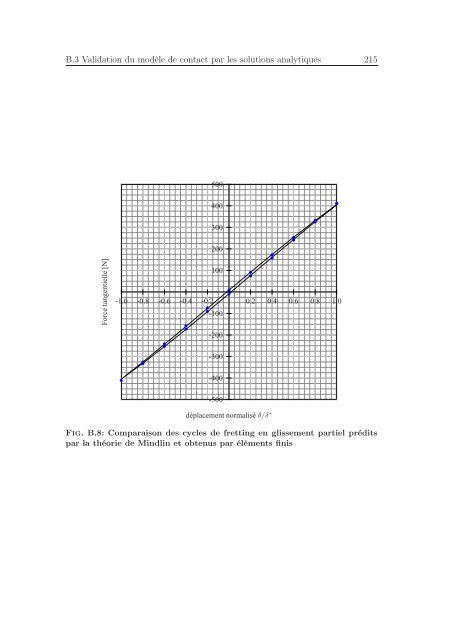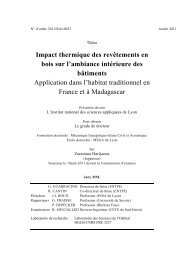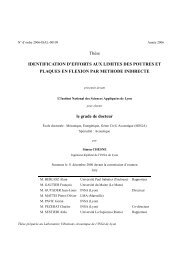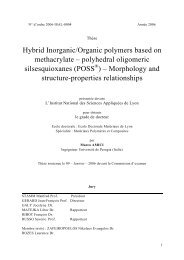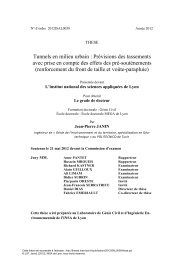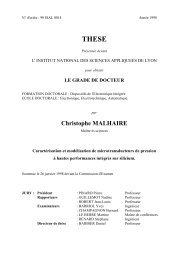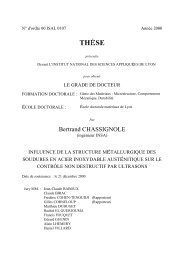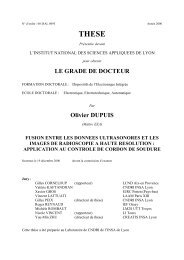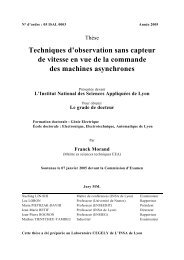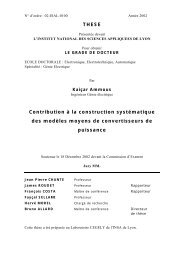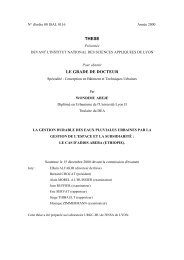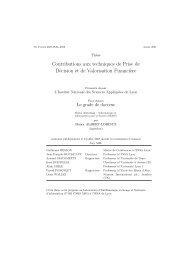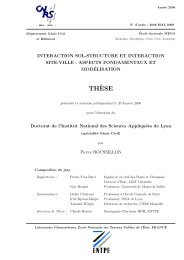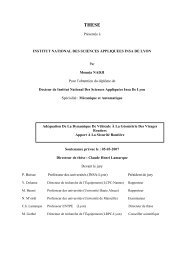- Page 1 and 2:
N o d’ordre : 05 ISAL 0002 Année
- Page 3 and 4:
ii TABLE DES MATIÈRES 3 Etude de l
- Page 5 and 6:
2 TABLE DES MATIÈRES
- Page 7 and 8:
4 Introduction et contexte industri
- Page 9 and 10:
6 Introduction et contexte industri
- Page 11 and 12:
8 Etat de l’art fatigue. La déso
- Page 13 and 14:
10 Etat de l’art seconde phase es
- Page 15 and 16:
12 Etat de l’art concentration de
- Page 17 and 18:
14 Etat de l’art La loi de Paris
- Page 19 and 20:
16 Etat de l’art 1.1.4 Le phénom
- Page 21 and 22:
18 Etat de l’art σ y répartitio
- Page 23 and 24:
20 Etat de l’art suivant. Mise en
- Page 25 and 26:
22 Etat de l’art le cas de l’al
- Page 27 and 28:
24 Etat de l’art le but étant al
- Page 29 and 30:
26 Etat de l’art f(ζ) donne le n
- Page 31 and 32:
28 Etat de l’art surface grain 1
- Page 33 and 34:
30 Etat de l’art fissures courtes
- Page 35 and 36:
32 Etat de l’art traçant par exe
- Page 37 and 38:
34 Etat de l’art Fig. 1.19: Effet
- Page 39 and 40:
36 Etat de l’art running conditio
- Page 41 and 42:
38 Etat de l’art a○ Q(t) b○ d
- Page 43 and 44:
40 Etat de l’art tout premiers st
- Page 45 and 46:
42 Etat de l’art 50 µm des grain
- Page 47 and 48:
44 Etat de l’art
- Page 49 and 50:
46 Méthodes et Techniques expérim
- Page 51 and 52:
48 Méthodes et Techniques expérim
- Page 53 and 54:
50 Méthodes et Techniques expérim
- Page 55 and 56:
52 Méthodes et Techniques expérim
- Page 57 and 58:
54 Méthodes et Techniques expérim
- Page 59 and 60:
56 Méthodes et Techniques expérim
- Page 61 and 62:
58 Méthodes et Techniques expérim
- Page 63 and 64:
60 Méthodes et Techniques expérim
- Page 65 and 66:
62 Méthodes et Techniques expérim
- Page 67 and 68:
64 Méthodes et Techniques expérim
- Page 69 and 70:
66 Méthodes et Techniques expérim
- Page 71 and 72:
68 Méthodes et Techniques expérim
- Page 73 and 74:
70 Méthodes et Techniques expérim
- Page 75 and 76:
72 Etude de la fissuration sous cha
- Page 77 and 78:
74 Etude de la fissuration sous cha
- Page 79 and 80:
76 Etude de la fissuration sous cha
- Page 81 and 82:
78 Etude de la fissuration sous cha
- Page 83 and 84:
80 Etude de la fissuration sous cha
- Page 85 and 86:
82 Etude de la fissuration sous cha
- Page 87 and 88:
84 Etude de la fissuration sous cha
- Page 89 and 90:
86 Etude de la fissuration sous cha
- Page 91 and 92:
88 Etude de la fissuration sous cha
- Page 93 and 94:
90 Etude de la fissuration sous cha
- Page 95 and 96:
92 Etude de la fissuration sous cha
- Page 97 and 98:
94 Etude de la fissuration sous cha
- Page 99 and 100:
96 Etude de la fissuration sous cha
- Page 101 and 102:
98 Etude de la fissuration sous cha
- Page 103 and 104:
100 Etude de la fissuration sous ch
- Page 105 and 106:
102 Etude de la fissuration sous ch
- Page 107 and 108:
104 Etude de la fissuration sous ch
- Page 109 and 110:
106 Etude de la fissuration sous ch
- Page 111 and 112:
108 Etude de la fissuration sous ch
- Page 113 and 114:
110 Etude de la fissuration sous ch
- Page 115 and 116:
112 Etude de la fissuration sous ch
- Page 117 and 118:
114 Etude de la fissuration sous ch
- Page 119 and 120:
116 Etude de la fissuration sous ch
- Page 121 and 122:
118 Etude de la fissuration sous ch
- Page 123 and 124:
120 Etude de la fissuration sous ch
- Page 125 and 126:
122 Etude de la fissuration sous ch
- Page 127 and 128:
124 Etude de la fissuration sous ch
- Page 129 and 130:
126 Etude de la fissuration sous ch
- Page 131 and 132:
128 Etude de la fissuration sous ch
- Page 133 and 134:
130 Etude de la fissuration sous ch
- Page 135 and 136:
132 Etude de la fissuration sous ch
- Page 137 and 138:
134 Etude de la fissuration sous ch
- Page 139 and 140:
136 Etude de la fissuration sous ch
- Page 141 and 142:
138 Etude de la fissuration sous ch
- Page 143 and 144:
140 Etude de la fissuration sous ch
- Page 145 and 146:
142 Modélisation de la fissuration
- Page 147 and 148:
144 Modélisation de la fissuration
- Page 149 and 150:
146 Modélisation de la fissuration
- Page 151 and 152:
148 Modélisation de la fissuration
- Page 153 and 154:
150 Modélisation de la fissuration
- Page 155 and 156:
152 Modélisation de la fissuration
- Page 157 and 158:
154 Modélisation de la fissuration
- Page 159 and 160:
156 Modélisation de la fissuration
- Page 161 and 162:
◽ 158 Modélisation de la fissura
- Page 163 and 164:
160 Modélisation de la fissuration
- Page 165 and 166:
≪uses≫ 162 Modélisation de la
- Page 167 and 168: 164 Modélisation de la fissuration
- Page 169 and 170: 166 Modélisation de la fissuration
- Page 171 and 172: 168 Modélisation de la fissuration
- Page 173 and 174: 170 Modélisation de la fissuration
- Page 175 and 176: 172 Modélisation de la fissuration
- Page 177 and 178: 174 Modélisation de la fissuration
- Page 179 and 180: 176 Modélisation de la fissuration
- Page 181 and 182: 178 Modélisation de la fissuration
- Page 183 and 184: 180 Modélisation de la fissuration
- Page 185 and 186: 182 Modélisation de la fissuration
- Page 187 and 188: 184 Modélisation de la fissuration
- Page 189 and 190: 186 Modélisation de la fissuration
- Page 191 and 192: 188 Modélisation de la fissuration
- Page 193 and 194: 190 Modélisation de la fissuration
- Page 195 and 196: 192 Modélisation de la fissuration
- Page 197 and 198: 194 BIBLIOGRAPHIE [12] P. C. Paris,
- Page 199 and 200: 196 BIBLIOGRAPHIE [42] W. Ludwig, J
- Page 201 and 202: 198 BIBLIOGRAPHIE [71] D. R. Swalla
- Page 203 and 204: 200 BIBLIOGRAPHIE [101] H. F. Bueck
- Page 205 and 206: 202 Historique des découvertes en
- Page 207 and 208: 204 Modélisation du fretting par
- Page 209 and 210: 206 Modélisation du fretting par
- Page 211 and 212: 208 Modélisation du fretting par
- Page 213 and 214: 210 Modélisation du fretting par
- Page 215 and 216: 212 Modélisation du fretting par
- Page 217: 214 Modélisation du fretting par
- Page 221 and 222: 218 Calculs de cristallographie en
- Page 223 and 224: 220 Calculs de cristallographie On
- Page 225 and 226: 222 Calculs de cristallographie Cet


